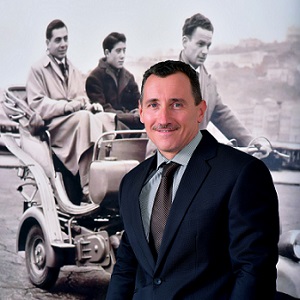OEMs journey to pre-COVID manufacturing, sales & overall growth

Piaggio has been into the manufacturing of a range of three-wheel public transport auto-rickshaws and lightweight goods transport vehicles. They also manufacture electric two-wheel motorcycles. With OEMs across the board taking a hit from lockdown, the path to recovery for each of them will be a journey to be followed and learnings have taken out of it. In this context, Telematics Wire discussed with Diego Graffi, CEO & MD, Piaggio Vehicles Pvt Ltd. Following are the excerpts of discussion-
The COVID19 has left automakers in difficult situations. What will be an important step going forward- production, sales, finance management, or something else?
Biggest limitations we see now for increasing sales turnover are as follows:
- Restrictions for dealers that are allowed to open to operate fully without limitations of timing and manpower;
- Willingness of financiers to take new cases, mainly for 3w passenger segment, due to limitations and restriction imposed for these vehicles to ply on roads in large part of India;
- Availability of manpower for supply chain, which is impacting their production capacity
- Overall weak sentiment in customers, due to uncertainty of the situation related to way forward for lockdown relaxations
In general, we have seen some positive signals for recovery in first 15 days of June, but now rumors related to some states that are thinking to reimpose lockdown again (though unreasonably, since it will not stop the spread of virus) is again hampering the recovery, dangerously since it will create further confusion in the entire ecosystem.
Will automakers look forward to more automation in the coming years. Could automation insulate production from such pandemics?
In our sector, we have already introduced full automation in some critical operations but being a manpower dependant kind of production, it is not possible to think that automation can be the solution.
Can we expect Piaggio to launch new models in the coming months? If yes, will they be tuned to address certain needs or changes in market demand?
Notwithstanding the heavy impact of extended lockdown in our revenues, we have maintained fully our investment plan in new products both for CV and scooter business; we are going to launch the new Aprilia SXR 160 before the end of this year. It was exhibited at AutoExpo 2020 in Delhi NCR in Feb’20 this year. This new scooter is about creating a new category, a sort of crossover between a sportbike and a maxi scooter through maintaining compact sizes. We will be introducing a new electric 3w vehicle with swappable and fixed battery configuration, following the big success achieved with Ape E City launched in Delhi at the end of 2019. We will also launch a new alternate fuel powertrain for our 3w portfolio, which can be a valid alternative to diesel ones in terms of performances, the total cost of ownership, and payload.
Will the lesser use of public transport due to COVID19, lead to increased personal mobility like scooters and motorcycles? Will Piaggio benefit from this?
We are in 3w passenger segment historically, so the limitation to shared mobility as a consequence of social distancing norms definitely will impact negatively the demand of this category of vehicles in the following, and we have seen already the effect in last 3 weeks since we restarted retail; in scooter business instead, we see definitely a good opportunity for quicker business recovery in the following period though not enough to regain gap respect to sales’ figures of last year same period.
What will be the effect of COVID-19 on the EV Industry?
There could be chances of EV growth in India being impacted by potential defocus from government and state authorities on infrastructures’ investment, due to the COVID-19 crisis. Another impact could come from OE suppressing investments on EV product portfolio development. There could be instead a benefit coming from big players of E-commerce in India looking more interestingly to EV cargo solutions for effective last-mile connectivity.
The majority of EVs are powered by lithium-ion batteries but its cost is high. Do you think India, being a price-sensitive market will explore other battery technologies?
We expect the cost of Li-ion battery to come down consistently in India in the next 2- 3 years, along with progressive localization of manufacturing of battery packs. We have already seen a positive downward trend in the cost of the battery in the last 3 years, but not yet enough to render the cost of electric vehicles competitive with ICE ones.
What are your views about FAME-II?
Can work for creating initial demand, compensating partially the gap in prices between electric vehicles and ICE ones, but if we want to create medium to long term robustness of electric mobility in India, investments for charging infrastructures development or for supply chain to localize components in India will be more helpful.
How viable is the concept of battery swapping, in your opinion?
Very viable, since it breaks the two biggest barriers that actually exist to convince customers to adopt an EV instead of a conventional ICE vehicles for his mobility needs:
- Gap in cost of acquisition in respect to ICE vehicles, since cost of battery is not part of vehicle price but it is owned by a third party;
- Range anxiety, since customer do not have to wait 4- 5 hours for his vehicle to be recharged but in just 2 minutes can do battery swap and restart plying his vehicle on road
The limitations coming from the availability of infrastructures (independently if they are for recharging or for battery swap) remain the same as for onboard fixed battery solutions.
As Piaggio has stepped into the era of connected mobility, how do you think the end-user will benefit in days to come?
Yes, we have successfully introduced connectivity into our EV 3w Ape e-city: through an app installed on his phone which dialogues with the vehicle, the customer at any point in time can check remaining charge of battery and autonomy of vehicle, can do basic diagnostic on vehicle functioning, can check on average speed of the day and kilometres run, can locate the nearest location for battery swap and number of batteries available there and lot other things. Also in our scooter gamma, we have introduced connectivity solutions that can allow customer to locate his vehicle in a parking lot, ask for service online, send a distress call if in panic and lot other possibilities.
Definitely we think that connected vehicles are the future of mobility in India since they offer customers immense possibilities beyond the pure usage of the vehicle itself for commuting or for doing business.
Published in Telematics Wire





